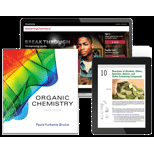
Interpretation: The two sets of diene and dienophile from the given compounds has to be predicted.
Concept Introduction:
Diels-Alder reaction:
A conjugated diene reacts with a compound containing a carbon-carbon double bond. It is a cycloaddition reaction, where two reactants form a cyclic product.
Conformation of Diene:
S-Cis Conformer: The double bonds are cis about the single bond (s stands for single), in an s-cis conformer.
S-trans Conformer:The double bonds are trans- about the single bond (s stands for single) in an s-trans conformer.
Condition for Diels-Alder reaction:
The conjugate diene must be in an s-cis conformation because when it is in an S-trans conformation, C-1 and C-4 are too far apart to react with the dienophile in a concerted reaction.
Want to see the full answer?
Check out a sample textbook solution
Chapter 8 Solutions
Mastering Chemistry with Pearson eText -- Standalone Access Card -- for Organic Chemistry (8th Edition)
- Which dienophile in each pair is more reactive in a Diels–Alder reaction?arrow_forwardWhat diene and dienophile are needed to prepare each compound by a Diels–Alder reaction?arrow_forwardRank the following dienes in their rate of reaction with the same dienophile in a Diels-Alder reaction. For example, 1 = fastest or most reactive diene, 4 = slowest or least reactive diene.arrow_forward
- Determine what conjugated diene and what dienophile wereused to make starting materials from a given Diels–Alder adduct ?arrow_forwardWhich of the following conjugated dienes will not react with a dienophile in a Diels–Alder reaction?arrow_forwardRank the following dienophiles in their rate of reaction with the same diene in a Diels-Alder reaction. For example, 1 = fastest or most reactive dienophile, 4 = slowest or least reactive dienophile.arrow_forward
- Although the Diels–Alder reaction generally occurs between an electronrich diene and an electron-deficient dienophile, it is also possible to have inverse-demand Diels–Alder reactions between suitable electrondeficient conjugated double bonds and electron-rich alkenes. These reactions are particularly useful because they allow for the incorporation of heteroatoms into the new six-membered ring. Predict the products of each inverse-demand Diels–Alder reaction below. Be sure your products reflect the correct stereochemistry. If more than one regioisomer is possible, draw both.arrow_forwardWhat diene and dienophile are needed to prepare each Diels–Alder product?arrow_forwardShow the starting diene and dienophile you could use to prepare the following molecule:arrow_forward
- Draw the conjugated diene and dienophile which can be reacted to give the Diels-Alder adduct shown belowarrow_forwardDraw the diene and dienophile (the starting materials) to produce the following compound.arrow_forwardA2 What is the inverse electron demand Diels–Alder reaction? Please pick a pair of a diene and a dienophile from the following dienes and dienophile that will undergo this type of reaction. Please show how this reaction works using Frontier Molecular Orbitals. What is the reaction product?arrow_forward
